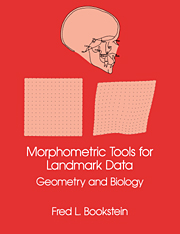3 - Landmarks
Published online by Cambridge University Press: 23 November 2009
Summary
“DISTANCE” AND DISTANCE
The common thread of the morphometric tactics in this book owes to their common rejection of the metaphor, otherwise universal in multivariate analysis, wherein dissimilarities between objects are called “distances” and are drawn as such on the page or the computer display. Underlying all linear multivariate techniques is one single geometric device, the modeling of summed-squared differences down the arbitrary list of “variables” of a study as ordinary (physical) distances in simulated physical space. Indeed, the findings of most linear multivariate strategies can be restated without error in the purely geometric language of vectors and angles. Variances are squared lengths, correlations are cosines, and so forth. In this root metaphor, measured variables are considered to specify perpendicular axes of a Euclidean space of however many dimensions. ‘Distance” is computed by the ordinary extension of the Pythagorean theorem: The squared distance between cases having measured values X1, X2 …, Xkand Yl, Y2, …, Yk is (Xl –Yx)2 + … +(Xk – Yk)2, just as for real points on real paper (k = 2) or in real space (k = 3). In this circumstance, both variables and cases are described by orthonormal sets of vectors of “loadings” linked by one diagonal matrix of singular values. Distances between cases derive from the crossproducts of their loadings with respect to this diagonal matrix, and the covariances of the variables are the cross-products of their loadings with respect to the same matrix.
In most applications of multivariate analysis there is no other definition of “distance” at hand except this metaphorical one.
- Type
- Chapter
- Information
- Morphometric Tools for Landmark DataGeometry and Biology, pp. 55 - 87Publisher: Cambridge University PressPrint publication year: 1992
- 4
- Cited by



